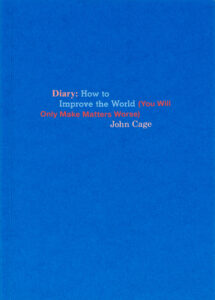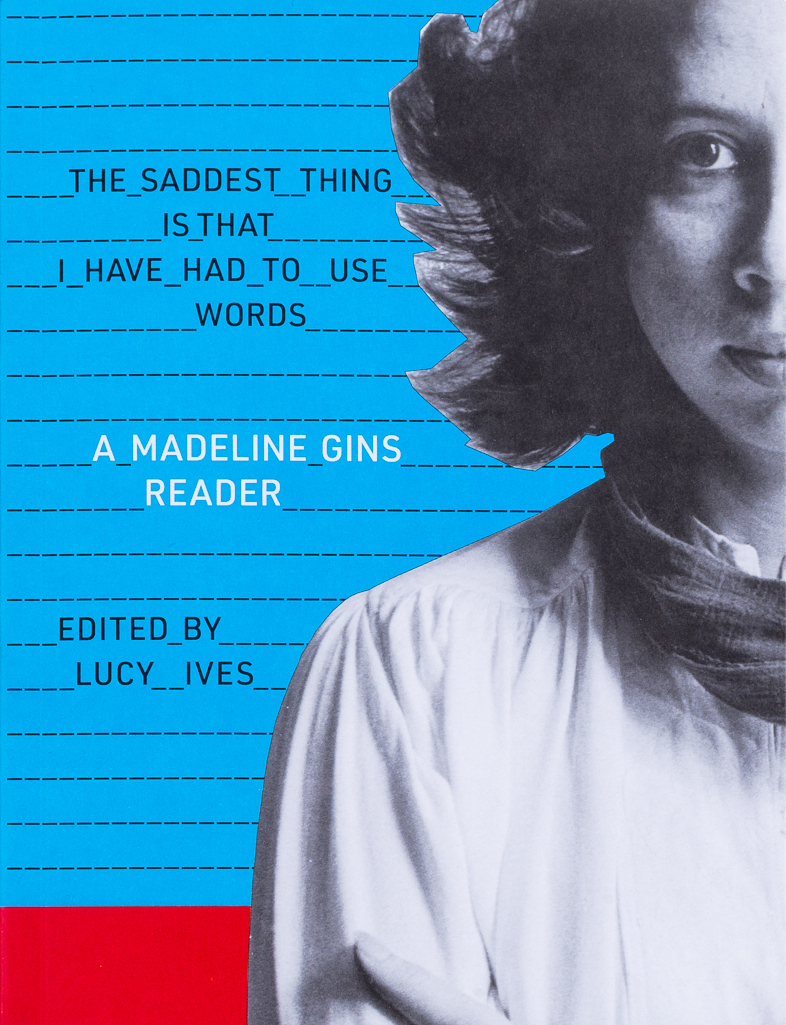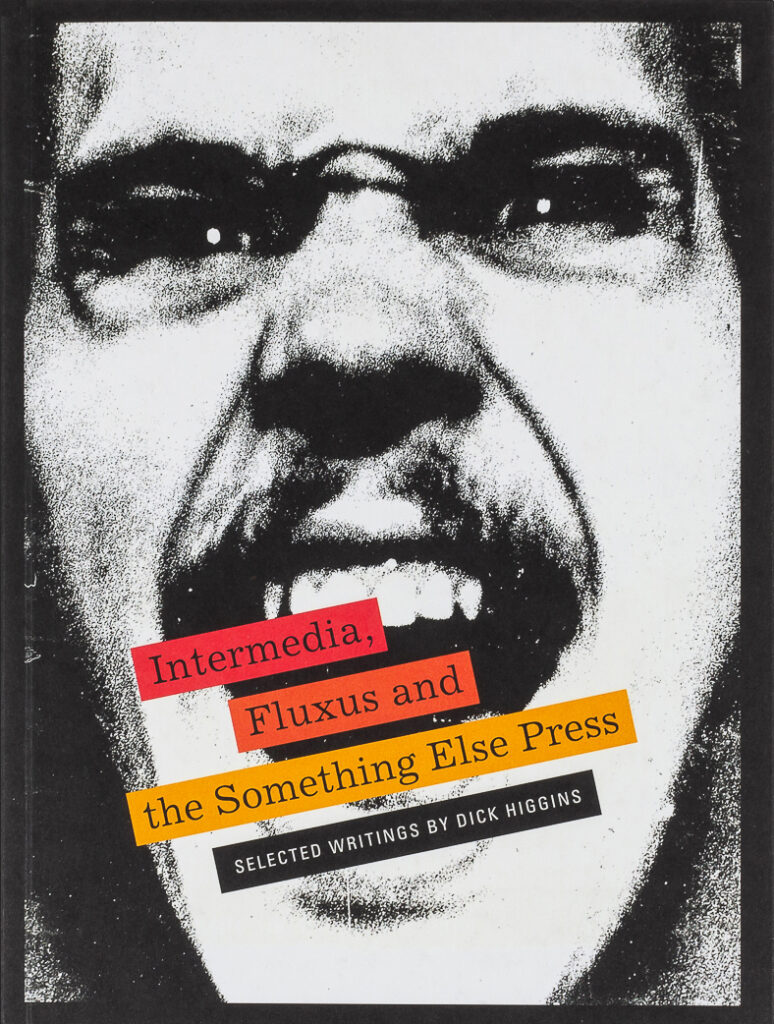Diary: How to Improve the World (You Will Only Make Matters Worse)
John Cage
Edited by Joe Biel and Richard Kraft with an afterword by David W. Rose

use code “turnthepage” for 15% off this title through 1/31
paper, 5.75 × 8.25 in.
146 pages, duotone and 24 color
978-1-938221-21-7
published in 2019
Second, expanded edition
2015 hardcover edition OP
Over sixteen years, beginning in 1965, John Cage compiled anecdotes, observations and koanlike tales, originally typing everything on an IBM Selectric and using chance methods to determine the formatting of texts that twist down each page. The Siglio [hardcover] edition preserves the graphic effects, but, more important, it gives a sense of the company he kept during these years—Marcel Duchamp, R. Buckminster Fuiller, D.T. Suzuki—and of his passionate feeling about a world locked in a state of perpetual warfare. Cage has a reputation for being a Zen-inspired wit. He was also much more, an intensely engaged moral thinker.
— Holland Cotter, New York Times
A repository of observations, anecdotes, proclivities, obsessions, jokes and koan-like stories, Diary: How to Improve the World (You Will Only Make Matters Worse) registers John Cage’s assessment of the times in which he lived as well as his often uncanny portents about the world we live in now. With a great sense of play as well as purpose, Cage traverses vast territory, from the domestic minutiae of everyday life to ideas about how to feed the world.
Cage used chance operations to determine not only the word count and the application of various typefaces but also the number of letters per line, the patterns of indentation, and color. The unusual visual variances on the page become almost musical as language takes on a physical and aural presence. While chance operations expand the possibilities of creating and shaping work beyond the limitations of individual taste and perspective, Diary nonetheless accumulates into a complex reflection of Cage’s own particular sensibilities as a thinker and citizen of the world, illuminating his social and political awareness, as well as his idealism and sense of humor: it becomes an oblique but indelible portrait of one the most influential figures of the 20th century American avant-garde.
Collecting all eight parts into a single volume, co-editors Biel and Kraft used chance operations to render the entire text in various combinations of the red and blue (used in the Great Bear pamphlet publication of Part Three) as well as to apply a single set of eighteen fonts to the entire work. This expanded paperback edition reproduces the 2015 hardcover edition. It also includes a new essay by mycologist and Cage aficionado David W. Rose and, most important, a significant addendum with over twenty facsimile pages of Cage’s handwritten notebook of a ninth part in progress. These previously unpublished pages bring the reader into compelling proximity to Cage’s process and the raw material from which it is made. In the editors’ note, Kraft and Biel succinctly elucidate the procedure of chance operations and demonstrate its application, giving readers a rare opportunity to see how the text is transformed.
read
Excerpts at Guernica and The Paris Review
about the author
Composer, philosopher, writer and artist, JOHN CAGE (1912–1992) blurred the boundaries between art and life, reframing the world so that it could be listened to and seen anew. A pioneer in extending the boundaries of music, often composing works through chance operations, Cage also had an extraordinary impact on dance, poetry, performance and visual art. Read “An Autobiographical Statement” at the John Cage Trust for more details on Cage’s life and work.
about the editors
JOE BIEL is a visual artist who shows with Galerie Kuckei/Kuckei in Berlin. He is the recipient of several awards including two from the Pollock-Krasner Foundation as well as residencies at the Bemis Center for Contemporary Art in Omaha and the 18th St Arts Center in Santa Monica. He lives and works in Los Angeles.
RICHARD KRAFT is a multi-disciplinary artist, the author of “It Is What It Is”: All the Cards Issued to Donald Trump and Here Comes Kitty: A Comic Opera, and co-curator of “Robert Seydel: The Eye in Matter” at the Queens Museum. He has also co-edited several Siglio titles including, most recently, Felix Gonzalez-Torres: Photostats.
press
Reviews in BOMB, Brooklyn Rail, Cyclic Defrost, Hyperallergic, London Review of Books, Los Angeles Review of Books and New York Times.
listen
John Cage reading Diary at Open Culture
A reading of Diary at the Hudson Basilica, July 31, 2016, recorded by WGXC
All Things Cafe: Conversations about John Cage hosted by Laura Kuhn, executive director of the John Cage Trust
see also
✼ natalie’s upstate weather report:
April 11, 2024 — The spring peepers have thawed (these little frogs freeze in winter) and now, unabashedly randy, they chirp. At first there was one, then two, and now it sounds like thousands. Two days ago, when it was truly spring, their adamantine chorus was almost deafening (we closed the windows to simply think!). Siglio has relocated to a lush, thriving hollow at the furthest most edge of the Berkshires after two years of peripatetics, sans library—which is now unpacked in a less than Benjaminian manner (little time to contemplate—our urgency in getting books on shelves mirrored the peepers need to mate). The first few months of 2024 were almost unendurable, but we’re home, spring is here, and there are books to made. We are singing!
[...]
